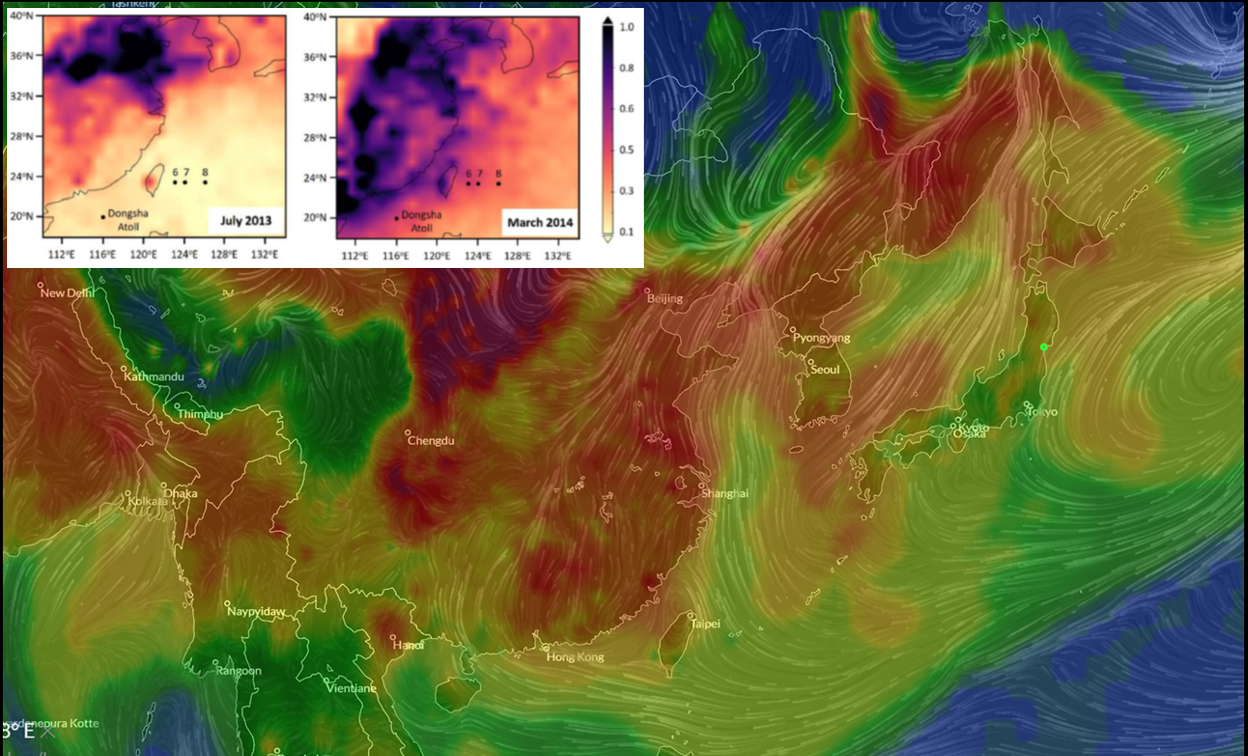


Figure: Anthropogenic aerosols produced by fossil fuel burning from East Asia, mixed with lithogenic dusts, are both transported to the marginal seas and the NWPO by winter/spring monsoon and the westerlies. Upper left figure compares the averaged monthly AOD (Aerosol Optical Depth) during our sampling months, which may be considered as relative aerosol concentrations. The aerosol transport modeling is based on Air Quality Index measured in East Asia, cited from https://airvisual.com/earth (April 29, 2018).
The supply of iron (Fe) to the euphotic zone plays an critical role on regulating the biogeochemical cycling of material in the ocean. In addition to nitrogen and phosphorus, Fe is one of the most important limiting factors for marine phytoplankton growth. In other words, when more bioavailable Fe is supplied to the surface water of the Fe-limiting oceanic regions, more phytoplankton would grow and elevate primary production, which transforms inorganic carbon (CO2) to particulate organic carbon by photosynthesis. Part of the organic carbon would sink down to the deep water and be buried in the sediment. Thus, Fe supply in the surface ocean not only influences carbon or other biologically material cycling but also influences atmospheric CO2 cycling and global climate.
Organisms living in aerobic environment may easily encounter the stress of Fe deficiency. Not only may marine phytoplankton growth be limited by Fe, so do human beings. The major reason is because Fe solubility is extremely low in oxic water with natural pH so that soluble Fe tends to precipitate and be removed in oxic environment. For example, pumping to the oxic environment, ferrous Fe in anoxic groundwater would be oxidized to ferric Fe and precipitated as iron oxyhydroxide (FeOOH) or iron oxide (Fe2O3). The Ying-Yang sea scene near the Jinguashi Mine is actually formed by the same process. The precipitated Fe cannot be transported far by water or oceanic current. So, soluble Fe in riverine or groundwater discharge would precipitate and be removed in estuaries or coastal water. On the other hand, as aerosols may be transported to the open ocean through aeolian pathway (Figure), aerosol Fe becomes the major Fe source in the surface water of the offshore or open ocean. The fate and bioavailability of soluble aerosol Fe in the surface water is an important question.
East Asia consumes tremendous amount of fossil fuel. The burning process emits great amount of anthropogenic aerosols (PM 2.5). Mixed with lithogenic aerosols originating from desserts, aerosols are transported by the northeastern monsoon and the westerlies to the marginal seas, the NWPO, or even the whole North Pacific Ocean (Figure). The major objective of this study was to explore the transformation processes of aerosol Fe after depositing in the surface water of the NWPO (Wang and Ho 2020). We collected aerosols, seawater, size-fractionated suspended particles, and sinking particles during seasonally representative low and high aerosol deposition months, 2013 July and March 2014, in the Western Philippine Sea. With one order of magnitude higher aerosol Fe contributed to the surface ocean in the spring month (Figure left upper), the elevated deposition of aerosols was not reflected in the dissolved Fe pool but the suspended pool. Elemental ratios further indicated that biotic and abiotic suspended particulate Fe exhibited size-dependent distribution patterns. Lithogenic particles originating from aerosol deposition were mainly in fraction ranging from 2 to 25 µm. Biotic particles smaller than 2 µm (mainly cyanobacteria) were the major carriers of surface precipitated/aggregated Fe. Due to the relatively small size and low density of biotic particles, the surface precipitated/aggregated Fe on small biotic particles shall possess longer residence time and higher bioavailability than the large and dense lithogenic particles in the euphotic zone. The input of anthropogenic aerosols may thus significantly increase bioavailable Fe inventory in suspended particle pools during winter and spring monsoon seasons in the NWPO. The information of the labile Fe inventory in small biotic particles appears to be essential to understand the biogeochemical cycling of bioavailable Fe in the surface ocean with high aerosol deposition.
Key points
More information